Lessico
Sparviero
Accipiter nisus
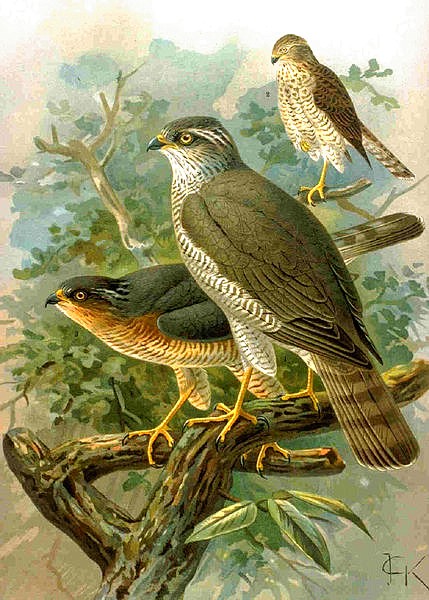
Johann
Friedrich Naumann (1780-1857)
Naturgeschichte der Vögel Mitteleuropas - 1905
Dal provenzale esparvier, dal germanico *sparwari, da sparwo, passero+ari, aquila. Accipiter nisus: uccello falconiforme della famiglia Accipitridi. Lungo sino a 35 cm (le femmine sono più grandi dei maschi), lo sparviero si distingue dagli altri uccelli da preda di dimensioni consimili per le ali ampie e arrotondate, la coda lunga e la colorazione che nei maschi è grigia superiormente, finemente barrata di rosso inferiormente; nelle femmine, invece, è brunastra sul dorso, barrata di grigio ventralmente.
Di corporatura snella, caratterizzato da un temperamento assai fiero, lo sparviero si alimenta di uccelli e di piccoli mammiferi. Frequenta soprattutto i boschi e le piantagioni, nidificando sugli alberi. Durante l'estate tende a spostare la propria distribuzione verso l'Europa settentrionale, portandosi verso le regioni meridionali in inverno; in Italia, tuttavia, vi sono anche individui stanziali.
Rappresenta
uno dei classici casi, come altri Falconiformi![]() e il Kiwi
e il Kiwi![]() ,
della presenza di 2 ovaie, ma l'ovidutto funzionante è quello sinistro, essendo quello destro per lo più inutilizzato, e talora
vestigiale. Si veda
per completezza la ricerca di Kinsky (1971) The consistent presence of paired ovaries in the Kiwi (Apteryx)
with some discussion of this condition in other birds
,
della presenza di 2 ovaie, ma l'ovidutto funzionante è quello sinistro, essendo quello destro per lo più inutilizzato, e talora
vestigiale. Si veda
per completezza la ricerca di Kinsky (1971) The consistent presence of paired ovaries in the Kiwi (Apteryx)
with some discussion of this condition in other birds![]() .
.
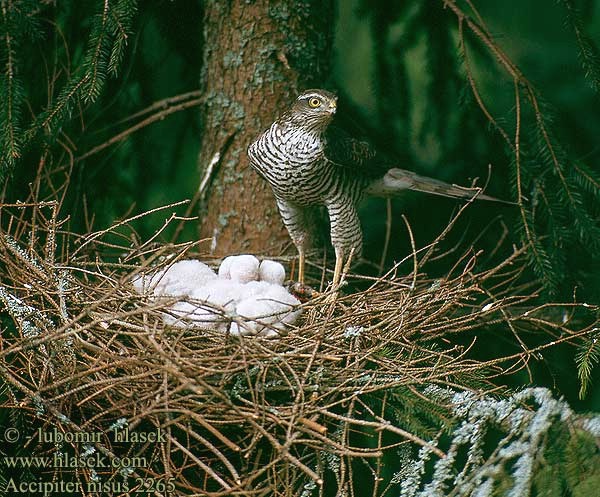
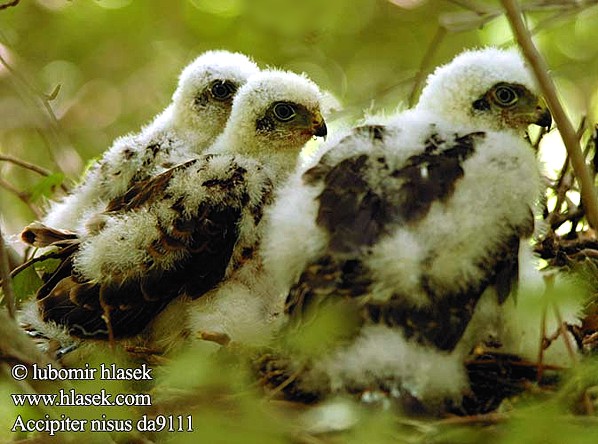
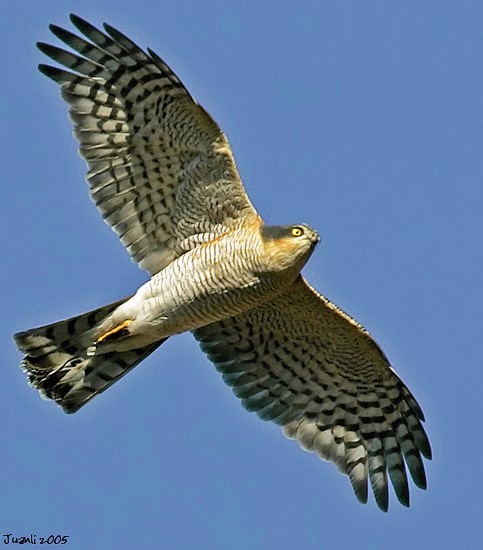
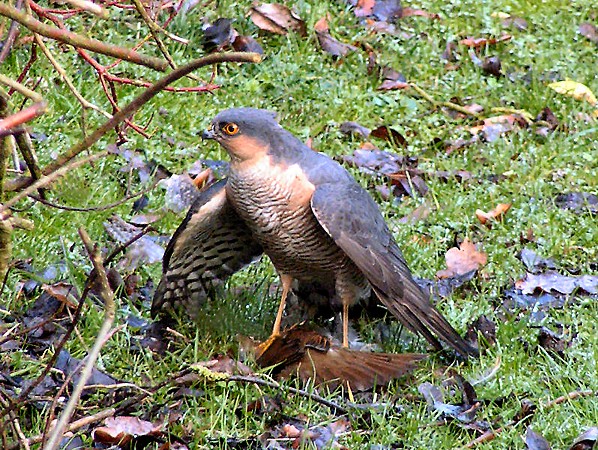
The
consistent presence
of
paired ovaries in the Kiwi (Apteryx)
with some discussion of this condition in other birds
by F. C. Kinsky, Wellington, New Zealand – 1971
Excerpt
Introduction
During 1966, while sexing an immature North Island Kiwi (Apteryx australis mantelli Barrier), it was found that the bird was a female and that it had paired ovaries. Both ovaries, showing the same stage of development, were of approximately equal size and well separated from each other. Only one oviduct, the left, was present.
A search through literature revealed only three references to the occurrence of double ovaries within the order Apterygiformes, i.e. Owen (1841:281 and 1849:300), repeated by the same author in 1879, and Fürbringer (1888:1446). These statements seem to have been overlooked by later workers, as no mention can be found of the occurrence of paired ovaries in Apteryx in recent literature.
Following the above chance discovery, every female Apteryx received at the Dominion Museum was carefully examined for paired ovaries and for the possible presence of a right oviduct or its vestigial remnants. In the period from 1967 to 1971, fifty one female Kiwis were received at the Museum and double ovaries were found in all of them. In addition it was found that successful ovulation from either ovary, or from both ovaries alternately within the same laying season, is a normal occurrence. Vestigial remnants of right oviducts were found in 3 instances only.
Previous work on paired ovaries in birds
Normally in birds, as opposed to other vertebrates, only the left ovary and oviduct reach functional development. Textbooks stress this fact, but admit that the order Falconiformes, in various species of which both ovaries may persist, forms an exception to the general rule: van Tyne and Berger (1958 : 38), Marshall (1961 : 193), Welty (1962 : 136), Darling and Darling (1963 : 181), and Thomson (1964 : 691--692). Marshall mentions, in addition (1961 : 193) that "in some nonraptorial species in which asymmetry is usual the primitive bilateral condition not infrequently arises", and also refers to Romanoff and Romanoff (1949 : 176), who state that "the frequency with which the right ovary persists in adult females of certain species is very high". This statement is followed by a small table listing the frequency of paired ovaries found in the following birds:
Hawk 50% (Gunn, 1912); Hawk 47.8% (Picchi, 1911) and Ringdove 23.5%, Common Dove 9.5%, Robin 4.8%, and English Sparrow 4.5% (Riddle, 1925).
Paired ovaries and paired oviducts develop simultaneously during early embryonic development, but both organs on the right side soon regress. Romanoff and Romanoff (1949) point out that the left oviduct in the 4 to 7 day old female chick embryo is already distinctly larger than the right and that in the 9-day old embryo, asymmetry in size, form and structure has become pronounced. At the time of hatching, the right ovary as compared with the left is diminutive and appears to be degenerating. Stanley and Witschi (1940) have found that the regression of the right oviduct in the Red-tailed Hawk begins after the eighteenth day of incubation (i. e. later than in the domestic chick). They also point out that the right oviduct, if persisting at the adult stage, is an inconspicuous vestige, and has never been found in a functional condition in hawks investigated during their studies.
It is difficult to explain the regression and usual disappearance of the right ovary and oviduct during the embryonic stage. Nevertheless, Darling and Darling (1963 : 181) point out that "here is another of the countless weight- saving adaptations found in birds". The authors themselves admit however, that this reasoning is not quite logical, as nearly 50% of all female birds of prey have paired ovaries. Welty (1962) suggests that the reduction in ovaries "from two to one is in part an adaptation to reduce ballast in a flying machine, but also is an arrangement which protects the developing egg. If birds had paired ovaries and oviducts, a sudden jolt of the body, as in alighting, might crack mature eggs located side by side in the parallel oviducts".
Witschi (1935) has found, however, that during the early development of bird embryos primordial germ cells undergo drastic movements and eventually concentrate on the left side. At the beginning of the third day of incubation the primordial germ cells are symmetrically distributed. In the course of the third day the germ cells from the left and right are brought together. This aggregation is immediately followed by a renewed separation of the germ cells into paired strands, of which the left always is the stronger, containing three to ten times as many germ cells as the right strand. The gonads become organized during the fourth day. They consist of a cortex and a medulla. While the gonads are forming, the primordial germ cells invade both cortex and medulla. At the end of the fourth day right and left medullae contain similar numbers of gonia so that the asymmetry arises, mainly if not exclusively, from the small number of germ cells in the right cortex. The author therefore concludes that "the asymmetry in the sex glands of birds is due to a primary, hereditarily fixed deficiency of the right cortical inductor. This deficiency is supposed to express itself in decreased attraction upon the primordial germ cells, especially during the phase of their redistribution in the early part of the third day" of incubation.
The asymmetry of oviducts, according to Witschi (1935) "might have evolved as an adaptation to the aviatic life habits of birds, whereas the more or less complete reduction of the right ovary followed later".
Kumerloeve (1955), mentions that the right side of an embryo contains fewer germ cells than the left side, and that therefore no cortex, or only a reduced cortex, develops. He then expresses the opinion that the regression of the right ovary and consequently of the right oviduct might be owing to lack of space and the increased pressure of other organs situated in the right side of the body cavity, i. e. the stomach, the liver, (the right lobe of which, except in Falconiformes, is always considerably larger than the left lobe), and last but not least by pressure exerted just in that region by the vena cava posterior, which is situated along the right side of the vertebral column. Kumerloeve also suggests that the reduction of the right ovary preceded the reduction of the right oviduct during evolution.
Without question paired ovaries have been found most commonly in the Order Falconiformes. And in most cases it has been recorded that the right ovary was the smaller of the two, although it often appeared to be functional. Stanley and Witschi (1940) state that the largest right ovaries occur with the true hawks (subfamily Accipitrinae), "whereas vultures and buzzards have the smallest right ovaries; the falcons holding an intermediate position". Stieve (1924) reports that in 50% of the cases in which double ovaries were found in Sparrow Hawks (Accipiter nisus), the right ovaries were smaller than the left, whereas in the other 50 % the ovaries were of equal size. Right ovaries larger than left ovaries were reported by Brodkorb (1928) with Circus c. hudsonicus and by Gunn (1912) with Accipiter nisus and Falco tinnunculus. As for the positioning of paired ovaries within the body cavity, Gunn (1912) points out that with Falconiformes the two ovaries are arranged (almost without exception) symmetrically and parallel to each other. With other birds Gunn states "the arrangement of the ovaries is more irregular and uncertain. They are seldom symmetrically placed, the general tendency being for the right ovary to move downwards and to the left, so that the whole of the left ovary and the greater part of the right are contained in the left half of the body cavity, one ovary more or less overlapping the other".
Double oviducts have not been found as often as double ovaries. Here again, they seem to predominate in the order Falconiformes, but for example have been found also in Ciconiiformes (Ciconia ciconia), in Anseriformes, Ralliformes, Columbiformes and Psittaciformes. Unfortunately not all authors who have found right oviducts reported if these were complete (i. e. possibly functional), or were only vestigial. Nevertheless, Gunn (1912) reports having found complete and seemingly functional right oviducts in Accipter nisus and in Falco tinnunculus. In particular he mentions one Sparrow Hawk in which "the right oviduct was double the width of the left and had the appearance of having recently passed eggs". In most cases, however, the right oviducts, if present, are only rudimentary, and the presence or absence of the vestigial right oviduct (with Hawks) is not directly correlated with larger or smaller size of the right ovary (Stanley and Witschi, 1940).
Anatomical proof of a fully functional right ovary, has been presented in only two cases. Stieve (1924) reports having obtained a female Goshawk (Accipiter gentilis) which was shot while incubating a clutch of 3 fresh eggs. On dissection he found that the bird had two ovaries, but only one oviduct. In addition to several larger ovules showing signs of regression, in both ovaries, he found two ruptured follicles on the left ovary and one ruptured follicle on the right ovary. This indicates that two of the 3 eggs of the clutch originated from the left ovary, whereas the third egg originated from the right ovary. As there was only one (the left) oviduct present, the author assumed that the ovum, following ovulation from the right ovary, had to wander over (Überwanderung) to the left side of the body to meet the oviduct.
In the second case White (1969) reports having dissected a female Peregrine (Falco peregrinus) obtained from Alaska, in which he found that "the left ovary was markedly atrophied and appeared never to have been functional. The right ovary had 5 enlarged follicles about 25 mm in diameter and two visible ovarian scars from which follicles had ruptured". From his findings, White concludes that "although two ovaries may be present, only one appears to be functional in egg production in any one season or perhaps throughout the life of the bird".
A most unusual case of paired reproductive organs was reported by Chappellier (1914). A domestic duck, which laid two eggs daily, was found to have double ovaries and double oviducts.
Table I has been drawn up from the literature available to the writer. It contains all orders and species of birds in which paired ovaries and paired oviducts have been found. This table shows that paired ovaries have been found in 86 species of birds belonging to 16 Orders, and paired oviducts have been found in 33 species belonging to 12 Orders. As mentioned above, paired ovaries and oviducts predominate in the Order Falconiformes (45 species) but have also been found in many additional species. The seemingly less frequent occurrences of double ovaries in other orders of birds might be due partly to the fact that they are not usually sought (Gunn 1912). However, as paired ovaries are well known in Raptors, they are probably automatically looked for in this order during routine dissections. If normal sexing routine for all birds included examination of the right half of the body cavity in addition to the usual examination of the left side only, more occurrences of paired ovaries and oviducts might possibly be found.
Summary
The ratite order Apterygiformes is the only group of birds in which:
1 - Paired ovaries occur consistently without known exceptions.
2 - The right ovary (as well as the left) is usually functional.
3 - Successful ovulation from the right ovary (as well as the left) is a normal occurrence.
4 - If more than one egg is laid during tho same season, ovulation occurs alternately from the two ovaries.
In addition the following points have also been established:
5 - In the North Island Kiwi irregular time intervals between egg laying within one clutch are apparently owing to the widely differing stages of development of the succeeding follicles at the time of laying of the preceding egg.
6 - Only the left oviduct is functional in Kiwis and vestigial right oviducts occur only rarely.
7 - From the evidence obtained during this study on Kiwis it appears that the reduction of the right oviduct in birds might well have preceded the reduction of the right ovary during their evolutionary history.
8 - Despite textbook statements paired ovaries in birds have been recorded in individual birds of at least 86 species belonging to 16 different orders and paired oviducts in birds have now been recorded in individuals of at least 34 species belonging to 13 different orders.
9 - Although it has long been known that paired ovaries occurred commonly but irregularly in some members of the carinate order Falconiformes, species of this group form only 52% of the total number of bird species in which paired ovaries have now been recorded. If normal sexing routine in birds included the examination of the right side of the body cavity in addition to the usual examination of the left side, additional species (and additional orders) with paired ovaries might well be found.